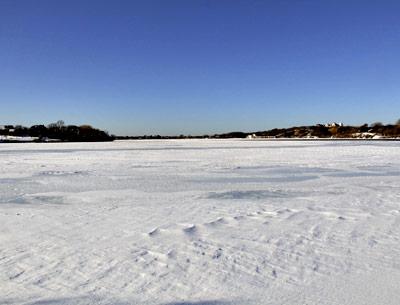Nature Notes: A Winter to Remember

It’s been quite a winter thus far. Snowing every other day for most of February, all of the freshwater ponds frozen over solid, including Long Island’s second largest, Fort Pond in Montauk. If Lake Montauk hadn’t been opened permanently and jettied in the first half of the 20th century, it would be frozen over, too.
This is the kind of winter I remember growing up as a kid in Mattituck in the 1940s. In those days most of us heated our houses with coal burned in a basement furnace. The heat came up through a central grill in the floor of the living room. Every night my father or brother would bank the coal so there was enough to last until morning. Every morning one of them would shake down the ashes, carry them out to the driveway, then put more coal on to keep producing heat during the day.
My grandfather had to keep his hundreds of white leghorn hens inside and their cotes heated with potbellied stoves when it went well below freezing, otherwise they would stop laying. We had to keep our 30 or so barred rock hens warm as well. The pigs didn’t stray from the pig house. Domestic pigs are not well furred like their wild ancestors; their fat keeps them insulated from the cold.
In the late 1940s there were a couple of winters when it got so cold Long Island Sound would freeze over to about a quarter mile out from shore and you could walk on it. Many of us youngsters did just that. No one fell through the ice to my knowledge, although it was treacherous at times. As long as there were winds and waves it would remain liquid, but come a quiet night at 15 degrees and the Sound’s near-shore water would freeze in a jiffy.
Sea ducks’ legs aren’t adapted to standing on the ice all night, the way Canada goose and puddle duck legs are. They are shorter and evolved for pushing them underwater. So when the Peconic Bay would start to freeze over in the 1940s and 1950s, the long-tailed ducks (a k a oldsquaw) would leave it and fly out to the Sound’s open water just before dusk. Canada geese on the South Fork often fly out and sit on open water in the ocean when their home ponds stay frozen over for weeks on end. Mute swans do the same, but prefer the Peconic Estuary’s open water to that of the ocean. Occasionally one will get semi-caught in the ice and have to struggle to break out.
There is a well-founded story of a red fox reaching Gardiner’s Island from mainland East Hampton during a frigid winter in the Great Depression era by walking across the ice. One red fox does not a family make and today the island is foxless.
Cold, ice, and snow cover affect overwintering birds in strange ways. On Saturday afternoon, a gang of male robins with bright red-orange breasts stormed into my yard and attacked the privet berries with a vengeance. Some starlings joined them. Privet berries are a least preferred dietary item for most birds, but the fact that they stay on the branches well into the spring makes them the choice of last resort. There were near gale-force winds at the time and the robins would rarely perch for more than a second or so. They would spend as much time hovering while picking off the individual dark blue berries as perching and feeding. Apparently they and the cedar waxwings, starlings, and yellow-rumped warblers had already removed the more preferred juniper berries from the eastern red cedars scattered around.
White-throated sparrows and juncos were feeding on leftover, still-on-the-stalks aster seed from my bountiful crop of white wood asters. Again, they save them for the last moment, preferring the birdseed put out by my neighbors, but sometimes covered over by snow that falls at night. Through it all, they kept their spirits high. When the sun shone brightly for a while on Sunday while it was still several degrees below freezing, the Carolina wrens and tufted titmice even managed to belt out several territorial songs, as if to show that their spirits had not been damped by the rigors of winter.
Iceboats have been sailing the Great South Bay ice for weeks now. Skaters have wiped the rust off the blades and, after clearing the snow from the ice on many South Fork ponds, have been having a great time slipping and sliding back and forth over it.
I look out my living room window at Noyac Bay and all I see is white. Notwithstanding the daily communiqués on the news about global warming, this is turning out to be a winter of the kind we had in the old days. It will certainly be one to remember. I wonder if the waterfowl, deer, squirrels, and winter birds that make it through to March will perk up come January 2015 and think to themselves, yes, it’s bad out, but nothing like last winter!
Larry Penny can be reached via email at [email protected].
